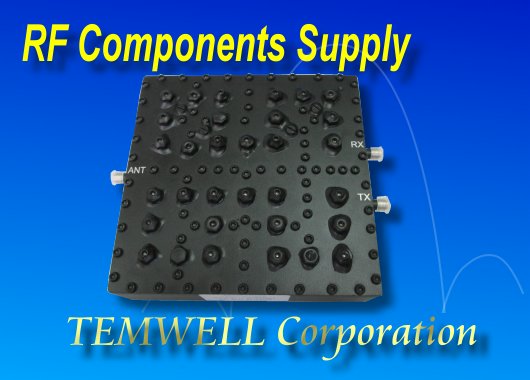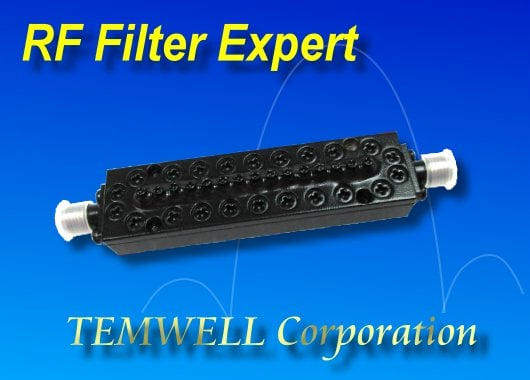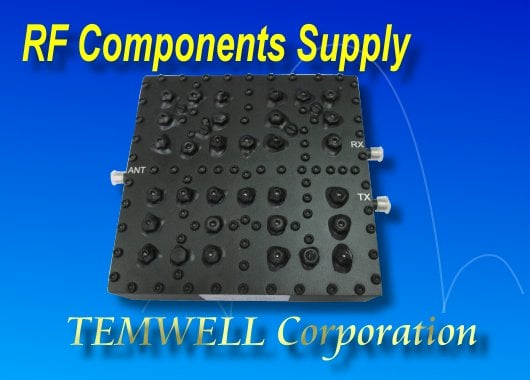The basic value of RF Filter: Bandwidth

RF filters are key components in wireless communication systems, determining which frequency signals are allowed to pass and which are blocked. Bandwidth is one of the most important parameters of RF filters.
Definition: What is the "bandwidth" of an RF filter?
Bandwidth (BW) is one of the important parameters of RF filters, used to indicate the frequency range that the filter allows signals to pass through. In RF filter specifications, bandwidth is usually expressed as the cutoff coordinate relative to the attenuation value. This range is marked on the response curve, usually with the –3 dB point as the reference. It is defined as the frequency difference in the passband where the insertion loss increases by 1 dB or 3 dB, i.e., BW = f₂ – f₁.
The bandwidth of a filter determines its ability to suppress and separate signals as well as its signal processing capacity: The narrower the bandwidth, the more precise the filter's suppression and separation capabilities, but the less signal can pass through; the wider the bandwidth, the greater the range of frequencies that can pass through, but the lower the suppression capability. During the design phase, a balance must be struck between passband efficiency and interference suppression based on the application requirements (such as communication systems, radar, or sensors) to ensure optimal overall system performance.
How do I determine whether the bandwidth value of an RF filter is good or bad?
There is no absolute "good" or "bad" in "bandwidth" itself; its advantages and disadvantages depend on the actual application requirements.
A. Wide bandwidth:
Suitable for multi-band or high-speed data transmission applications, such as radar or broadband communication systems.
Advantages: Suitable for systems that need to process signals with a wide range of frequencies, such as multi-band communications.
Disadvantages: Due to the wide range of signals allowed, the filter's selectivity is relatively poor, making it more susceptible to interference from nearby signals outside the passband.
B. Narrow bandwidth:
Suitable for applications requiring high selectivity and strong noise suppression, such as wireless communication and receiver front-end filtering.
Advantages: Extremely high selectivity, accurately selecting the desired frequency and strongly suppressing nearby interference signals.
Disadvantages: Very sensitive to signal center frequency drift, making design and manufacturing more difficult.
Generally speaking, a narrowband filter is needed if you want to allow only specific frequency signals to pass through. A wideband filter is needed if you want to support multi-band or high-bandwidth applications. Therefore, there is no standard of "wider is better" or "narrower is better", but rather it depends on the system requirements.

Common RF Filter Bandwidth Displays: -1dB Bandwidth or -3dB Bandwidth
Bandwidth (BW) is a key metric for RF filters, describing the frequency range over which the filter allows signals to pass. In RF filter specifications, bandwidth is typically expressed as the range marked on the response curve relative to the cutoff point, using the attenuation value as the coordinate. Common definitions include –1 dB bandwidth and –3 dB bandwidth.
The -3 dB bandwidth is the most commonly used definition in the industry, representing the distance between two frequency points (f₁, f₂) in the filter's passband where the insertion loss increases by 3 dB compared to the peak value, i.e., BW = f₂ – f₁. Within this range, the signal power is approximately 50% of the maximum value, clearly defining the filter's main passband range. The calculation method is simple and easy to compare, therefore it is widely used in various design and testing standards.
–1 dB bandwidth is used in high-precision applications such as radar, satellite communications, or high-linearity systems. It means that the power in the passband is attenuated by only about 10%, which can more carefully reflect the flatness and signal fidelity of the filter.
The difference between the two lies in their design focus: –3 dB bandwidth emphasizes the energy passing range in the passband, evaluating the filter's selectivity; while –1 dB bandwidth focuses on passband uniformity and signal quality. Therefore, engineers will choose between the two definitions based on system requirements to achieve the optimal balance between performance and practicality.
How do I find the RF Filter bandwidth value from the curve graph?
The performance of RF filters is typically measured using a network analyzer and represented by an K21 transmission coefficient graph.
(1). Find the center frequency (𝑓𝑐):
On the 𝑆21 curve, find the point with the minimum insertion loss. The frequency corresponding to this point is the center frequency (𝑓𝑐).
(2-1). Determine the -3 dB reference point:
Add 3 dB to the minimum insertion loss value (assuming -1.0 dB) to obtain the cutoff attenuation value (Levelcutoff = 1 dB + 3 dB).
(2-2) or Determine the -1 dB reference point:
Add 1 dB to the minimum insertion loss value (assuming -1.0 dB) to obtain the cutoff attenuation value (Levelcutoff = 1 dB + 1 dB).
(3) Reading the Cutoff Frequencies:
In the 𝑆21 curve, use the attenuation value of Levelcutoff to find the two frequency points: the upper cutoff frequency (𝑓𝐻) and the lower cutoff frequency (𝑓𝐿).
(4) Calculate out bandwidth value:
The difference between the upper cutoff frequency (𝑓𝐻) and the lower cutoff frequency (𝑓𝐿) is the -3 dB bandwidth . or -1 dB bandwidth. (BW = 𝑓𝐻 - 𝑓𝐿).
Additional Information: Passband Flatness of RF Filter Bandwidth
When discussing bandwidth, in addition to focusing on the width of the passband, passband flatness is also an important indicator of filter quality. It describes the variation in insertion loss across the filter's bandwidth and reflects the amplitude consistency of the signal after it passes through. Ideally, the passband should remain flat, allowing all frequency components to pass uniformly without distortion. If passband flatness is poor, some frequency components may be excessively attenuated, resulting in reduced communication performance or signal waveform distortion.
An good filter should have minimal attenuation variation within its passband (e.g., less than 0.5 dB or 1 dB), and the flatter the curve, the better. A filter with poor passband flatness will cause signal distortion within the passband. Good passband flatness ensures stable signal transmission within the bandwidth and is an essential design requirement for high-quality filters.
Temwell's Bandwidth Design and Service Introduction
Precise bandwidth and performance control are crucial to successful RF system design. Temwell deeply understands the impact of bandwidth on filter selectivity, communication quality, and signal stability. Therefore, in every custom design, we rigorously control bandwidth-related parameters, including –3 dB bandwidth, –1 dB bandwidth, and passband flatness.
Temwell uses a high-precision network analyzer (N/A) for measurement and verification, ensuring that the measured bandwidth is highly consistent with the simulated results. Our product specifications fully present the true performance of each filter, enabling engineers to accurately understand system behavior.
Whether designing for narrowband high-rejection or broadband low-loss applications, Temwell provides professional analysis and manufacturing, ensuring your filter maintains optimal passband flatness and stability across the entire bandwidth. Choosing Temwell means choosing precise, stable, reliable and professional RF filter services.
If you are interested in Customized RF Filter Service, feel free to contact us and get free consultation services so that we can provide you with the best solution.
Subscribe to us on Facebook for the latest product news.




















